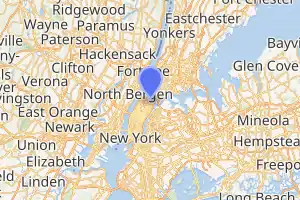Carver Houses
Carver Houses, or George Washington Carver Houses, is a public housing development built and maintained by the New York City Housing Authority (NYCHA) in Spanish Harlem, a neighborhood of Manhattan.[3][4]
Carver Houses | |
|---|---|
 | |

Location in New York City | |
| Coordinates: 40.7906°N 73.9506°W | |
| Country | United States |
| State | New York |
| City | New York City |
| Borough | Manhattan |
| Area | |
| • Total | 0.022 sq mi (0.06 km2) |
| Population | |
| • Total | 2,646 [2] |
| ZIP codes | 10029 |
| Area code(s) | 212, 332, 646, and 917 |
| Website | my |
Carver Houses has 13 buildings, on a campus with an area of 14.63 acres (5.92 ha).[3] Nine of those (I-II, V-IX, XII-XIII) are fifteen stories tall, while the other four (III-IV, X-XI) are six stories tall.[5] The development is bordered by East 99th Street to the south, East 106th Street to the north, Park Avenue to the east, and Madison Avenue to the west.[3] In addition, East 102nd Street and East 104th Street run through the campus.[6] The nine buildings of Carver Houses have a total of 1,246 apartments housing approximately 2,723 residents.[3]
About
The Carver houses replaced brownstones and tenement buildings which were demolished through slum clearance, displacing residents.[7] During construction, crews discovered they were building over Montague's Creek, which fed into Hell Gate.[8] The first buildings of the development were completed in 1955,[9] and the complete development was finished on January 31, 1958.[3] Kahn & Jacobs designed the complex[5] which is named after George Washington Carver (1864-1943), an African American chemist, botanist, and educator who, despite being born a slave, developed many uses for soybeans, peanuts, and sweet potatoes.[3] The playground was designed by landscape architect M. Paul Friedberg whose climbable sculpture was inspired by Isamu Noguchi.[10] The project was funded by the state and rentals cost $12 a room.[11] Once completed, the neighborhood saw a population decrease from over 2,000 residents to around 1,200.[7]
In December 1970, led by the Young Lords, tenants organized a rent strike until NYCHA provided more police officers to help preserve their community.[12]
In 2007, GrowNYC installed a community garden on the property.[13]
As of 2010, Alberta Slappy is serving as Resident Association President for Carver Houses, and is a member of the Manhattan South District Citywide Council of Presidents.[14]
Carver Houses is serviced by the twenty-third precinct of the New York City Police Department, and is governed by Manhattan Community Board 11.[15][16]
Notable people
- Gregorio Marzán (1906–1997), Puerto Rican artist
References
- "Carver Houses Area". Retrieved November 7, 2019.
- "Carver Houses Population".
- "Carver, George Washington Houses". NYCHA Housing Developments. New York: New York City Housing Authority. Archived from the original on June 4, 2011. Retrieved January 18, 2010.
- "El Barrio (Spanish Harlem)". nyc.com. New York: NYC.com Inc. Retrieved January 18, 2010.
- "George Washington Carver Houses, New York City". Emporis.com. Emporis Corporation. Archived from the original on June 4, 2011. Retrieved January 18, 2010.
- "1475 Madison Ave, New York, NY 10029". Google Maps. Google, Inc. Retrieved January 18, 2010.
- Bell, Christopher (December 6, 2012). East Harlem Remembered: Oral Histories of Community and Diversity. McFarland. ISBN 9780786492541.
- "About New York; Hydroponic Cellar Farm Yields Bean Sprouts As Crop--Old Creek Under Carver Houses". New York Times. May 16, 1956. Retrieved June 26, 2019.
- "TENANTS REJOICE IN CARVER HOUSES; Aged Get First 8 Apartments in Uptown Project -- Special Features Have Big Appeal". New York Times. January 26, 1955. Retrieved June 26, 2019.
- "The Forgotten Artistic Playgrounds of the 20th Century". Hyperallergic. May 6, 2016. Retrieved June 26, 2019.
- "Last 29 Families About to Quit Carver Houses Site in Harlem; Tenants About To Be Moved How Site Was Cleared Record Auto Toll in California". New York Times. October 4, 1956. Retrieved June 26, 2019.
- Umbach, Gregory Holcomb; Umbach, Fritz (2011). The Last Neighborhood Cops: The Rise and Fall of Community Policing in New York Public Housing. Rutgers University Press. ISBN 9780813549064.
- "George Washington Carver Garden for Living | GrowNYC". www.grownyc.org. Retrieved June 26, 2019.
- "Manhattan South District CCOP Office". Residents' Corner. New York: New York City Housing Authority. Archived from the original on June 13, 2010. Retrieved January 18, 2010.
- "NYCHA GIS". NYCHA Housing Developments. New York: New York City Housing Authority. Retrieved January 18, 2010.
- "District Map". cb11m.org. New York: Manhattan Community Board 11. Archived from the original on January 26, 2010. Retrieved January 18, 2010.